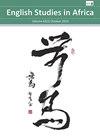Nairobi Street-Aesthetics: Distance and Proximity in the Aesthetics of Everyday Life in the Green City
IF 0.5
4区 文学
0 LITERATURE
引用次数: 0
Abstract
Abstract This article looks at the relatively recent tendency to aestheticize life in Nairobi’s working-class and informal neighbourhoods in different forms of art and media. It focuses on two case studies – Steve Bloom’s photobook, Trading Places: The Merchants of Nairobi (2009) and the first issue of the Kenyan literary magazine Kwani? (2003). These are compared to the collectively performed poem ‘Mistaken Identity’ (2019) by a group of poets from the neighbourhood of Kayole, to show that the street aesthetics in the two cases rest on distance, while the meaning-making in the poem rests on proximity. Distance in this context takes several forms, such as the gap between socio-economic classes and actual physical distance, but I register it on the level of epistemology. The poem also articulates a form of epistemological proximity between, first, the forms of meaning-making that can be seen in both the text and the visual and performative components of the video, and, second, the place that is portrayed. Rather than arguing that proximity is preferable to distance as a basis of meaning-making, this article attempts to theorize the emergence of a specific aesthetic. This aesthetic presents itself as an aesthetic because the particular forms of social stratification and concomitant social distance between communities and neighbourhood (which have emerged in Nairobi since 2000) allow an economic, political and cultural elite to re-discover the city, which they experience as simultaneously strange and familiar.内罗毕街头美学:绿城日常生活美学中的距离与接近
摘要这篇文章着眼于内罗毕工人阶级和非正规社区最近通过不同形式的艺术和媒体将生活审美化的趋势。它聚焦于两个案例研究——史蒂夫·布鲁姆的摄影集《交易场所:内罗毕商人》(2009)和肯尼亚文学杂志《夸尼?(2003)。将这些与一群来自Kayole社区的诗人集体表演的诗歌《错误的身份》(2019)进行比较,以表明这两种情况下的街道美学取决于距离,而诗中的意义则取决于接近。在这种情况下,距离有几种形式,比如社会经济阶层之间的差距和实际的物理距离,但我把它放在认识论的层面上。这首诗还阐明了一种认识论上的接近形式,首先,可以在文本和视频的视觉和表演成分中看到的意义创造形式,其次,被描绘的地方。本文并没有认为距离比接近更适合作为意义形成的基础,而是试图将一种特定美学的出现理论化。这种美学表现为一种美学,因为特殊形式的社会分层以及社区和邻里之间随之而来的社会距离(自2000年以来在内罗毕出现)使经济、政治和文化精英能够重新发现这座城市,他们体验到这座城市既陌生又熟悉。
本文章由计算机程序翻译,如有差异,请以英文原文为准。
求助全文
约1分钟内获得全文
求助全文

 求助内容:
求助内容: 应助结果提醒方式:
应助结果提醒方式:


